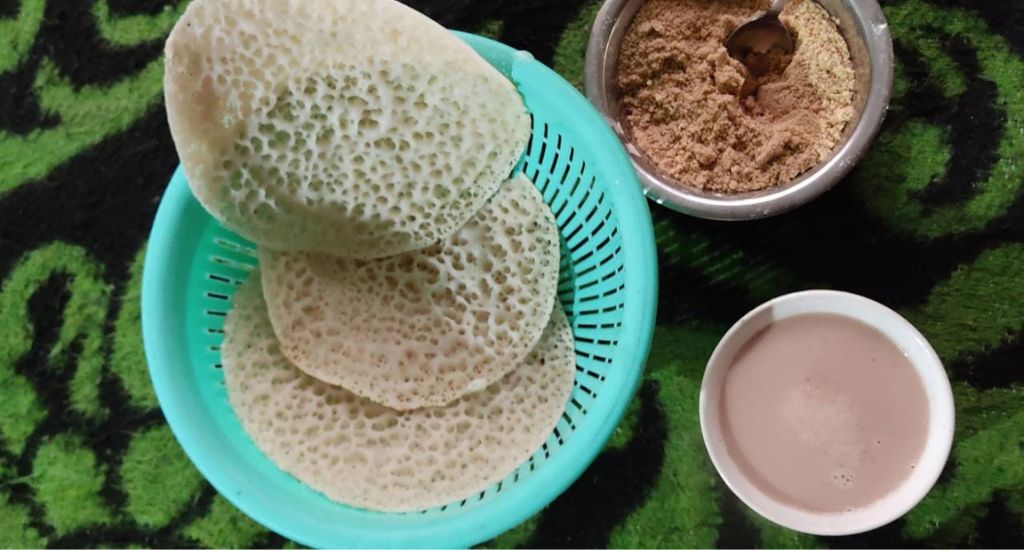
Be in the pink this winter with Kashmiri noon chai
A symbol of Kashmir’s culture – salty, heavy noon chai – is brewed in evaporated milk and served hot at tea stalls and homes alike.

A symbol of Kashmir’s culture – salty, heavy noon chai – is brewed in evaporated milk and served hot at tea stalls and homes alike.
This winter, if you’re feeling cold, thirsty or even a bit of “deja brew” – then get a pink-purple “par-tea” started.
You may take these puns with a pinch of sea salt, but you can’t do without sodium if your regular beverage fix is a totem of Kashmiri culture – noon chai.
For the uninitiated, noon is the local word for salt and chai, well, come on, you know that part.

This salty tea gets its earthy pink colour from baking soda and the extensive aeration from boiling milk, both which give it a glutinous texture. It is also called sheer chai, but the other name brews more familiarity.
To begin with, boil water and brew green tea leaves, till frothy. Put baking soda, whisk vigorously, and add cardamom powder and more water. Some even add crushed almonds, pistachios and cinnamon.
Let the tea steep till it turns bright red. Now add milk and whisk again for a slight froth. The colour will change to a lovely dark pink. Let the milk evaporate to a thick consistency.
Wait for the perfect colour and then, of course, add salt and serve hot.

This concoction is well known for keeping locals and travellers “in the pink” when the cold mountain air cuts through the bones.
Picture this. On a wind-whipped December morning in south Kashmir’s apple town of Shopian, people gather in ones and twos like silhouettes outside their favourite chaiwala’s roadside tea stall before it opens. The trickle swells to a crowd by the time a picture-perfect sun peeks through the Pir Panjal peaks and paints Mohammad Amin Wagay’s time-worn tea kettle a vibrant gold.
The 52-year-old tea master’s clientele comprises mostly lorry drivers ferrying the crunchiest and sweetest Kashmiri apples from one of the Valley’s biggest fruit markets to the hungry plains. A journey of 1,000 miles begins with a single steep and the noon chai keeps them awake. And warm.

Wagay’s shop is just one of many that dot the landscape along solitary, winding mountain roads, serving noon chai typically in a glass.
At Qazigund market en route to Banihal pass on the Jammu-Srinagar national highway, a trucker from Srinagar wraps his fingers around a glass of hot tea and slowly savours it with slurpy sips.
Slurps are encouraged, a satisfying sign of salute to the brewer.
“This is my favourite spot to hit the brakes. After travelling through the night, there’s nothing more refreshing than a glass of morning chai,” said Muzamil Ahmad. “The noon chai here is a must.”
Also Read | Kangri still keeps Kashmir warm in winter
For Kashmiris it is tea time anytime, especially in the lazy, snowy winters when everyone turns to the beloved staple to keep them grounded and warm.
Mornings are my favourite. All the family members gather for chai. We have modern kettles, but we prefer to pour our chai from a samovar
But what you get at tea stalls just skims the surface.
Noon chai serves a deeper meaning by the fireside in Kashmiri homes.
Family members bond over tea every morning and evening, sitting close in a circle on thick carpets with wisps of steam wafting from the “samovar” and the aroma of freshly baked “tschot” or “girda” flatbreads filling the room. A happy sight.
This gloopy tea is more tasty and soothing than any chocolate shake
Tea and laughter are a true matcha made in heaven.
“Mornings are my favourite. All the family members gather for chai. We have modern kettles, but we prefer to pour our chai from a samovar,” said Shaheena Bano, a self-confessed tea addict.

Every morning she fires up the samovar – which traces its origin to Russia of yore, but has come to be associated with Kashmir and its famed tea. It’s a large vessel, often made of copper or brass, with a spigot on one side and a handle on the other.
The salty tea is served with kander tschot (flatbreads). Kander means baker, thus tschot made in a furnace at the local bakery is called so. There’s makai tschot, made of maize flour, and girda from a fermented dough. Dry fruits and biscuits go well too.
“This gloopy tea is more tasty and soothing than any chocolate shake,” said Ayaan Ali, a teenager in north Kashmir’s Pattan village.
They say noon chai accompanies a Kashmiri from cradle to grave, and everything in between like childbirth rituals, birthdays, weddings and all forms of reunions. Samovars bubbling with chai are a common sight when mourners visit a family to console and pay respect to the dead.
Noon chai’s history is as rich as the vast Pir Panjal range. A similar salty tea is a favourite in central Asia and Tibet. It probably came to Kashmir about a thousand years ago when the Silk Road passed through the Valley and great caravans of traders plodded on it.
So, it can be surmised that an “oolong” time ago, Chinese travellers brought green tea leaves and Kashmiris added milk and rock salt to it. Now, don’t ask which alchemist’s “crea-tea-vity” concocted this timeless recipe.
Just wrap your fingers around the warmth, drink and enjoy.
The lead image at the top shows a hot cup of pink salt tea also known as “Nun chai” with kander tschot (flatbread) (Photo by Nasir Yousufi)
Nasir Yousufi is a journalist based in Srinagar.